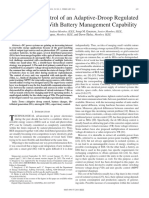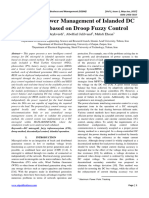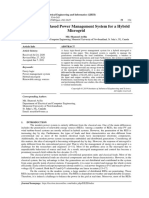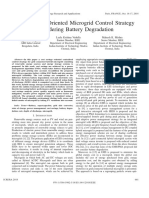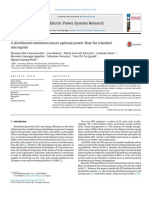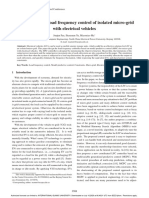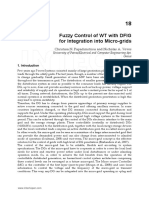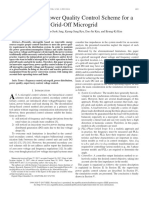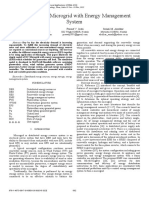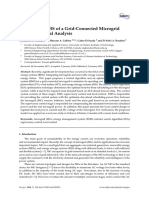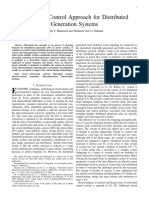Professional Documents
Culture Documents
Energy Based Battery Management System For Microgrids Using Fuzzy Logic Controller
Original Title
Copyright
Available Formats
Share this document
Did you find this document useful?
Is this content inappropriate?
Report this DocumentCopyright:
Available Formats
Energy Based Battery Management System For Microgrids Using Fuzzy Logic Controller
Copyright:
Available Formats
Volume 2, Issue 5, May 2017 International Journal of Innovative Science and Research Technology
ISSN No: - 2456 - 2165
Energy based Battery Management System for
Microgrids using Fuzzy Logic Controller
Sushma Maney.D Eranna
Dept. of Electrical and Electronics Engineering Dept. of Electrical and Electronics Engineering
Dr. Ambedkar Institute of Technology Dr. Ambedkar Institute of Technology
Bangalore, India Bangalore, India
sushmamaney17@gmail.com eranna64@gmail.com
Abstract This paper presents an energy management by the load, the inclusion of Energy Storage System(ESS)
system to effectively mitigate grid power profile (e.g. batteries, flywheels, ultra-capacitors) and Energy
fluctuations. The system assumes that neither renewable Management Systems(EMS) are highly recommended in order
generation nor the load demand is controllable. This to improve the system stability and its performance. In
energy management system consists of a low complexity general, MGs are capable to work in both grid-connected and
Fuzzy Logic Controller embedded with 25 rules in it. The stand-alone mode. They are defined a slow voltage systems
approach is, monitoring rate of change in energy and State comprised of loads, Distributed Generation(DG) units and
of Charge (SOC) of battery thus controlling the power storage devices ,that are connected to the mains at a single
delivered/absorbed by the grid. Point of Common Coupling(PCC).
Keywords Distributed power generation, energy In short, for the case under study, the EMS should be designed
management, fuzzy control, micro grid, Renewable energy with the objective of smoothing the power exchanged with the
sources and smart grid. grid, concurrently satisfying at any time the load demand (i.e.
there is no demand side management) and the ESS constraints.
I. INTRODUCTION This heuristic knowledge suggest the use of Fuzzy Logic
Control to the design of the EMS for the case under study,
This paper presents the modeling, analysis and design of fuzzy since this approach easily integrates the experience of the user
logic controller in a Battery management system for a Wind/ rather than using a mathematical model of the system. Taking
Solar hybrid system. With the variation of wind speed, solar the same input variables as in[1], the authors presented in [2]
isolation and the load demand, the fuzzy logic controller the design of a FLC with only 25-rules which slightly
works effectively by turning on and off the batteries. The improved the battery SOC and the grid power profile obtained
entire designed system is modeled and simulated using in[1].This work presented a detailed description of the rule-
MATLAB/Simulink Environment. The control process of the base and the Membership Functions (MF) design, which
battery charging and discharging is non-linear, time varying parameters (i.e. number and mapping) were adjusted to
with time delays. It is a multiple variable control problem with optimize a set of quality criteria of the MG behavior through
unexpected external disturbances. Many parameters such as an off line learning process simulation.
the charging rate, the permitted maximum charging current,
the internal resistor, the port voltage, the temperature and Furthermore, using the same design methodology, an
moisture, etc. keep changing during the charging and improved EMS design based on FLC was presented in [3].
discharging process cant be directly obtained, so it is difficult This new design was considering the MG Net Power Trend
to achieve the optimal operation performance by using (NPT) as an additional input of the FLC, resulting in a 50-
traditional control methods. Hence a fuzzy control unit for rules FLC. Even though the results evidence a low-frequency
battery charging and discharging used in a renewable energy grid power profile with minimum fluctuations, the controller
generation system is developed. complexity was increased.
The environmental and economic benefits related to the Additionally, a common drawback of all these previous
reduction of both carbon dioxide emission and transmission designs [1], [2], [3] is that they do not operate properly when
losses have made distributed renewable generation systems the RES generation exhibits strong differences from one day
became a competitive solution for future smart grids. In this to the next one. In these cases, the battery SOC can eventually
context micro grids are considered as the key building blocks reach the undesired thresholds, thus compromising the battery
of smart grids and have aroused great attention in the last lifetime. With the aim of improving the aforementioned
decade for their potential and the impact they may have in the designs as well as simplifying the FLC complexity (i.e. to
coming future. reduce the controller inputs number and its rule-base), this
work presents a new FLC-based EMS of only two-inputs, one-
The Microgrid (MG) concept has been discussed by several output and 25-rules. As it will be seen, the key factor of the
authors. Additionally ,in a MG scenario due to the stochastic new design is to consider the MG Energy Rate - of - Change
nature of both the renewable sources and the power consumed (ERoC) as an input in order to anticipate the system behavior.
IJISRT17MY119 www.ijisrt.com 382
Volume 2, Issue 5, May 2017 International Journal of Innovative Science and Research Technology
ISSN No: - 2456 - 2165
The design methodology will follow the procedure and the the battery out of the secure limits, the EMS strategy should
optimization process developed in [2] (i.e. off-line controller cut off the power delivered / absorbed by the battery.
parameter setting process).
In these cases PBAT = 0, or equivalently according to (3) P GRID
The paper is organized as follows. Section II describes the = PLG meaning that all the power fluctuations are handled by
architecture and variables of the Energy Management System. the grid. A battery SOC estimator, shown in Fig. 2 is used to
Section III describes the Microgrid. Section IV is about the estimate the current battery SOC, which is expressed as:
proposed FLC Design and Section V presents the design of the
proposed fuzzy Implementation. The experimental validation SOC (n) = SOC (n-1) - SOC (n), (6)
of the proposed EMS design is presented in Section VI.
Finally, Section VII presents the main conclusions of this Where SOC(n) represents the battery energy variation during
paper. the sampling period Ts and can be estimated using the general
definition of the energy evolution ei of a power variable Pi
II. ENERGY MANAGEMENT SYSTEM during a period time T. Therefore, for sampled variables and
assuming equal integration and sampling periods (i.e . T =
Ts). The case under study assumes that the wind and PV
The system consists of Wind Turbine (WT), Photovoltaic modules are in charge of extracting the maximum renewable
conversion modules and a battery charger sharing the same power and that the AC load power consumption is not
DC bus. The system also includes a bidirectional inverter- controllable. In other words, PLOAD and PGEN (hence PLG)
rectifier module controlling the power exchanged with the cannot be controlled. In contrast, the power exchanged with
load. the grid PGRID will be controlled by means of the bidirectional
inverter - rectifier, where as the battery charger will handle, if
able to, the resulting battery power PBAT according to (3).
Finally the main aim of the EMS design is to control the
power inverter-rectifier in order to smooth the power profile
exchanged between the grid(i.e. minimizing the grid power
fluctuations and power peaks) while concurrently keeping the
battery SOC within secure limits.
III.MICROGRID DESCRIPTION
Fig. 1. Energy Management System for Residential Grid
The study developed in this paper is carried out for a
Referring to Fig.1, the power fluxes are considered positive microgrid with renewable energy sources and domestic load.
according to the direction of the corresponding arrows. The The MG includes a domestic AC load with a rated power of
net power ,PLG,and the grid power ,PGRID,can be expressed 4kW, a Photovoltaic (PV) array of 1 kW, a small Wind
as follows: Turbine (WT) of 2.5kW, and an ESS formed by a lead-acid
battery bank with a rated capacity of 40kWh. The grid
PLG=PLOAD PGEN, (1)
PGEN = PPV+PWT, (2) power quality criteria is defined so that the lower the criteria
PGRID = PLG - PBAT, (3) values are, the EMS performance is better.
Where PLOAD is the load power, PGEN is the renewable A. Positive and Negative Grid Power Peaks
source generated power, PPV is the photovoltaic power, PWT
is the wind turbine power and PBAT is the battery power. The positive and negative grid power peaks, PG,MAX and
PBAT depends directly to the battery SOC, which should be PG,MIN, are defined as the maximum value of power
kept at any time between a minimum and maximum limits, delivered by the grid.
SOCMIN and SOCMAX, respectively, to preserve the battery
lifetime namely: B. Maximum and Average Power Derivative
SOCMIN SOC (n) SOCMAX , (4) The Maximum Power Derivative (MPD) is defined as the
where: maximum absolute value of the slopes during one full sample
time.
SOCMIN = (1-DOD).SOCMAX, (5) The Average Power Derivative (APD) is defined as the
absolute value of the annual average value of the slopes of two
DOD being the battery Depth of Discharge. This study consecutive samples.
considers a maximum DOD of 50%, since the lifetime of this
type of battery is significantly reduced when operates at high
DOD levels[36].In order to avoid discharging/ overcharging
IJISRT17MY119 www.ijisrt.com 383
Volume 2, Issue 5, May 2017 International Journal of Innovative Science and Research Technology
ISSN No: - 2456 - 2165
IV. PROPOSED FLC DESIGN demand and to keep the battery SOC within secure limits.
Consequently, the controller output allows the interaction
An improved FLC- based EMS design is presented in this between the MG and the mains.
section with the aim of minimizing the power peaks and
fluctuations in the grid power profile while keeping the battery
SOC evolution within secure limits as well as to reduce the
FLC complexity .
s
The new fuzzy EMS design suggests computing the grid
power as the sum of the average value of the MG net power,
PAVG(n), and an additional component, PFLC(n) which is in
charge of modifying the grid power profile to keep the battery
SOC within the secure limits at any time.
Thus, the grid power profile is defined as follows:
PGRID(n) = PAVG(n) + PFLC(n), (7)
The proposed design computes by means of a FLC the
additional component PFLC (n) from the following two
inputs: Fig.3. Fuzzy EMS designed on MG energy rate- of change
and SOC block diagram
i. The SOC of the battery SOC(n),
The control block diagram of this strategy is shown in Fig.3,
ii. The MG energy rate -of- change, PAVG(n) where PAVG (n) is obtained from PLG (n) by means of a
LPF, PAVG (n) is obtained by a digital filter which
The FLC uses the SOC of the battery, SOC (n), as an input to implements and limiting the high-frequency gain and noise
check its value at any time in order to fit the constraints associated with the derivative term [41].Fig.3 also includes the
imposed by the maximum DOD of the battery and to preserve battery SOC Estimator and the fuzzy controller.
its life. Furthermore, PAVG(n) gives to the FLC the
information of the magnitude of the MG energy change of two V. FUZZY IMPLEMENTATION
consecutive samples as shown in Fig.2.
The Fuzzy implemented here is a Mamdani -based inference
and defuzzification of Center of Gravity with two - inputs,
PAVG(n) and SOC(n), and one-output PFLC(n), which
represents the second component of the grid power. Regarding
the FLC design, the adjustment of all parameters involved in
the fuzzy controller (e.g. number of MFs per Input / output,
type, mapping, rule - base).
The procedure followed is described and summarized in the
next steps:
Fig.2.Slopes produced by two consecutive samples and Step1:Set the initial FLC design.
average net power profile. Set the MF of inputs and outputs variables: number ,type and
mapping. Set the initial rule-base.
In this regard, a positive slope in Fig. 2 (e.g. m1, m4, m5, m6,
m8) means a reduction of the renewable power generation or Step2: Adjust the inputs and outputs MFs. Using the real
an increase of the load consumption in the MG. On the recorded data, adjust the inputs / outputs parameters of the
contrary, a negative slope (e.g. m2, m3, m7) corresponds to a MFs to minimize the quality criteria of Section III.
MG renewable power generation increase or a load
consumption decrease. Step3: Optimize the initial rule -base. Using the real recorded
data, adjust the initial rule base to minimize the quality
It is worth noting that PAVG (n) can be understood as the criteria.
local prediction of the battery SOC future behavior if the grid
power is not modified. For this reason, from the information By analysis of previous papers and previous experimental
of SOC(n) and PAVG(n) the FLC is in charge to modify results, the optimization process leads to optimized FLC rule-
PFLC(n) to increase, decrease or maintain the power delivered base presented in Table I.
/absorbed by the mains to concurrently satisfy the load power
IJISRT17MY119 www.ijisrt.com 384
Volume 2, Issue 5, May 2017 International Journal of Innovative Science and Research Technology
ISSN No: - 2456 - 2165
Table I :- Optimized Flc Rule-Base
As a result of this rule - base five triangular MFs shown in
Fig.4 and are defined for each input variable, and correspond
to five fuzzy subsets noted as NB, NS, ZE, PS and PB where Fig. 5 a. PGEN b. PLOAD c. PBAT
B represents Big, S Small, N Negative, P Positive and
ZE Zero. VI. EXPERIMENTAL VALIDATION
The proposed Fuzzy Logic design for Energy Management
System is programmed in Matlab/Simulink platform. In order
to experimentally validate the proposed EMS, the system has
been tested in laboratory conditions. The experimental results
are as shown in Fig. 5. The difference between generated
power and load power is stored in the battery. If the difference
is positive the battery charges and if negative battery
discharges. This is experimentally validated under laboratory
condition.
VII. CONCLUSION
In this proposed model a design of fuzzy logic control to
achieve optimization of a Battery management system for a
Wind/ Solar hybrid system is presented. According to the
variation of the load, the fuzzy logic controller works
(a) Input variable input 1
effectively by charging and discharging the battery as per the
grid status. Simulation results were obtained by developing a
detailed dynamic hybrid system model. From the simulation
results, the system achieves power equilibrium, and the battery
SOC maintains the desired value for extension of battery life.
The control process of the battery charging and discharging is
non-linear, time-varying with time delays. It is a multiple
variable control problem with unexpected external
disturbances. A fuzzy control unit for battery charging and
discharging used in a renewable energy generation system is
developed. Simulation results based on fuzzy strategies show
that the control unit has satisfied performance in a laboratory
environment.
Current work is focused on the extension of the proposed
approach by implementing predictive method of control for
(b) Input variable input 2 better system efficiency.
Fig.4. Input Variable membership functions.
IJISRT17MY119 www.ijisrt.com 385
Volume 2, Issue 5, May 2017 International Journal of Innovative Science and Research Technology
ISSN No: - 2456 - 2165
VIII. REFERENCES [15] W.A. Bissch off and R.Gouws, Energy management
system for a residential grid-tied micro-grid, in 2015
s[1] D. A. Aviles, F. Guinjoan, J. Barricarte, L. Marroyo, P. International Conference on the Domestic Use of Energy
Sanchis, and H. Valderrama, Battery management fuzzy (DUE), CapeTown, SouthAfrica,Mar.2015,pp.8591.
control for a grid- tied microgrid with renewable generation, [16] H. Zhou, T. Bhattacharya, D. Tran, T.S.T. Siew, and
in IECON 2012 - 38th Annual Conference on IEEE Industrial A.M. Khambadkone, Composite Energy Storage System
Electronics Society, Montreal, QC, Canada, Oct. 2012, pp. Involving Battery and Ultra capacitor With Dynamic Energy
56075612. Management in Microgrid Applications, IEEE Trans .Power
[2] J. J. Barricarte, I. S. Martn, P. Sanchis, and L. Marroyo, Electron., vol.26, no.3, pp.923930,Mar.2011.
Energy Management Strategies For Grid Integration Of
Microgrids Based On Renewable Energy Sources, in 10th
Int. Conf. Sustain. Energy Technol., Istambul, Turkey, Sep.
2011, pp. 47.
[3] D. Arcos-Aviles, N. Espinosa, F. Guinjoan, L. Marroyo,
and P. Sanchis, Improved Fuzzy Controller Design for
Battery Energy Management in a Grid Connected Microgrid,
in IECON 2014 - 40th Annual Conference on IEEE Industrial
Electronics Society, Dallas, TX, USA, Oct. 2014, pp. 2128
2133.N.
[4] P. Siano, C. Cecati, H. Yu, and J. Kolbusz, Real time
operation of smart grids via FCN networks and optimal power
flow, IEEE Trans. Ind. Inf., vol. 8, no. 4, pp. 944952, Nov.
2012.
[5] R. H. Lasseter, MicroGrids, in Proc. Power Eng. Soc.
Winter Meeting, Jan. 2002, vol. 1, pp. 305308.
[6] F. Katiraei, R. Iravani, N. Hatziargyriou, and A. Dimeas,
Microgrids management, IEEE Power and Energy Mag.,
vol. 6, no. 3, pp. 5465, May. 2008.
[7] Pan and S. Das, Kriging Based Surrogate Modeling for
Fractional Order Control of Microgrids, IEEE Trans. Smart
Grid, vol. 6, no. 1, pp. 3644, Jan. 2015.
[8] Q. Jiang, M. Xue, and G. Geng, Energy management of
microgrid in grid-connected and stand-alone modes, IEEE
Trans. Power Syst., vol. 28, no. 3, pp. 33803389, Aug. 2013.
[9] D. E. Olivares, C. A. Caizares, and M. Kazerani, A
centralized energy management system for isolated
microgrids, IEEE Trans. Smart Grid, vol. 5, no. 4, pp. 1864
1875, Jul. 2014.
[10] N. Hatziargyriou, Microgrids: Architectures and
Control, Chichester, UK: Wiley, 2014, pp. 124.
[11] R. Palma-Behnke, C. Benavides, F. Lanas, B. Severino,
L. Reyes, J. Llanos, and D. Saez, A microgrid energy
management system based on the rolling horizon strategy,
IEEE Trans. Smart Grid, vol. 4, no. 2, pp. 9961006, Jun.
2013.
[12] P. Malysz, S. Sirouspour, and A. Emadi, An optimal
energy storage control strategy for grid-connected
microgrids, IEEE Trans. Smart Grid, vol. 5, no. 4, pp. 1785
1796, Jul. 2014.
[13] M. Yazdanian and A. Mehrizi-Sani, Distributed Control
Techniques in Microgrids, IEEE Trans. Smart Grid, vol. 5,
no. 6, pp. 29012909, Nov. 2014.
[14] G.Bruni,S. Cordiner, V. Mulone, V. Rocco, and F.
Spagnolo, A study on the energy management in domestic
micro-grids based on Model Predictive Control strategies,
Energy Conversion and Management, vol.102,pp.50
58,Sep.2015.
IJISRT17MY119 www.ijisrt.com 386
You might also like
- Feminist Philosophy of Religion (Stanford)Document35 pagesFeminist Philosophy of Religion (Stanford)Jagad-Guru DasNo ratings yet
- Design and Fabrication of Electric BikeDocument47 pagesDesign and Fabrication of Electric BikeHarish Dangeti100% (1)
- Competing Risks and Multistate Models With RDocument249 pagesCompeting Risks and Multistate Models With RJuanCarlosAguilarCastro100% (1)
- Ralph M. McInerny - Aquinas and Analogy (1996, Catholic University of America Press)Document182 pagesRalph M. McInerny - Aquinas and Analogy (1996, Catholic University of America Press)cuba esquivel amadeoNo ratings yet
- Microgrids Black StartDocument7 pagesMicrogrids Black StartLalit ChoudharyNo ratings yet
- Dramatherapy With Children and Adol PDFDocument265 pagesDramatherapy With Children and Adol PDFTiiTii BátrizNo ratings yet
- Stuart Wilde: Csodák Pedig VannakDocument31 pagesStuart Wilde: Csodák Pedig VannakRita AsztalosNo ratings yet
- Energy Storage for Sustainable MicrogridFrom EverandEnergy Storage for Sustainable MicrogridRating: 4 out of 5 stars4/5 (3)
- Trends in Linguistics - Studies and MonographsDocument550 pagesTrends in Linguistics - Studies and MonographsNelly PaniaguaNo ratings yet
- Design - Implementation - and - Operation - of - An - Education - Laboratory-Scale - Microgrid - IEEE Access Apr.2021Document18 pagesDesign - Implementation - and - Operation - of - An - Education - Laboratory-Scale - Microgrid - IEEE Access Apr.2021Chaymae MarzoukiNo ratings yet
- GalleyProof 1 (21M 12 699) GalleyProof Original ASTESJ 070204Document21 pagesGalleyProof 1 (21M 12 699) GalleyProof Original ASTESJ 070204MoulayMoulyNo ratings yet
- Defining Control Strategies For MicroGrids Islanded OperationDocument9 pagesDefining Control Strategies For MicroGrids Islanded OperationNaveen AmarasingheNo ratings yet
- Economic Power Dispatch of Distributed Generators in a Grid-Connected MicrogridDocument8 pagesEconomic Power Dispatch of Distributed Generators in a Grid-Connected MicrogridAlamson SitanggangNo ratings yet
- mayada5977 مهمDocument7 pagesmayada5977 مهمAmmar Al-KindyNo ratings yet
- Smart Energy ystem for Distributed Management SDocument5 pagesSmart Energy ystem for Distributed Management SHARMET UP3 PEMATANGSIANTARNo ratings yet
- Distributed Optimal Energy Management in MicrogridsDocument10 pagesDistributed Optimal Energy Management in MicrogridsFlorin NastasaNo ratings yet
- Supervisory Control of An Adaptive-Droop Regulated DC Microgrid With Battery Management CapabilityDocument12 pagesSupervisory Control of An Adaptive-Droop Regulated DC Microgrid With Battery Management CapabilityMashood NasirNo ratings yet
- Intelligent Power Management of IslandedDocument11 pagesIntelligent Power Management of Islandedjijo123408No ratings yet
- Ejemplo de Paper 1Document9 pagesEjemplo de Paper 1xdddd123aNo ratings yet
- Multi-Mode Control Strategy For A Stand-Alone Wind Energy ConversionDocument19 pagesMulti-Mode Control Strategy For A Stand-Alone Wind Energy ConversionBahija KOUHAILNo ratings yet
- EnergiesDocument26 pagesEnergiesContafull AmongNo ratings yet
- 1final Iete - Forth Revision1Document10 pages1final Iete - Forth Revision1Dr. Monika JainNo ratings yet
- (2010) Cooperative Control Strategy of Energy Storage System and Microsources For Stabilizing The Microgrid During Islanded OperationDocument12 pages(2010) Cooperative Control Strategy of Energy Storage System and Microsources For Stabilizing The Microgrid During Islanded Operationabc1231234454252452342No ratings yet
- 1 s2.0 S0378779622008823 MainDocument17 pages1 s2.0 S0378779622008823 MainSouhila Rached ZINENo ratings yet
- Real-Time Analysis of The Control Structure and Management Functions of A Hybrid Microgrid SystemDocument6 pagesReal-Time Analysis of The Control Structure and Management Functions of A Hybrid Microgrid SystemJitender KaushalNo ratings yet
- 2627 6534 1 PBDocument12 pages2627 6534 1 PB0overpower0No ratings yet
- Cost Savings Oriented Microgrid Control Strategy Considering Battery DegradationDocument6 pagesCost Savings Oriented Microgrid Control Strategy Considering Battery DegradationKumarNo ratings yet
- 2nd Control of Single-PhaseDocument37 pages2nd Control of Single-PhaseCaptain GamerNo ratings yet
- Energies 16 06188Document33 pagesEnergies 16 06188LeonelAlejandroNo ratings yet
- Control and Protection of Power Electronics Interfaced Distri-Buted Generation Systems in A Customer-Driven MicrogridDocument8 pagesControl and Protection of Power Electronics Interfaced Distri-Buted Generation Systems in A Customer-Driven MicrogridHedra GirgisNo ratings yet
- Electric Power Systems ResearchDocument13 pagesElectric Power Systems ResearchsureshNo ratings yet
- Paper 11 (Scientific Reports)Document20 pagesPaper 11 (Scientific Reports)MBADJOUN DanielNo ratings yet
- Important 23 PDFDocument6 pagesImportant 23 PDFMuhammad Atiq Ur Rehman 22-FET/PHDEE/S19No ratings yet
- Mitigating The Impact of Distributed PV in A Low-Voltage Grid Using Electricity TariffsDocument8 pagesMitigating The Impact of Distributed PV in A Low-Voltage Grid Using Electricity TariffsM8ow6fNo ratings yet
- Time-Delay Effect On Load Frequency Control For MicrogridsDocument6 pagesTime-Delay Effect On Load Frequency Control For MicrogridsPEPITO PEREZNo ratings yet
- 10 35378-Gujs 899799-1649221Document20 pages10 35378-Gujs 899799-1649221TabishNo ratings yet
- Optimal FACTS Placement Toolbox Maximizes LoadabilityDocument3 pagesOptimal FACTS Placement Toolbox Maximizes LoadabilityksbnNo ratings yet
- Multifunctional Control For PV Integrated Battery Energy Storage System With Enhanced Power QualityDocument11 pagesMultifunctional Control For PV Integrated Battery Energy Storage System With Enhanced Power QualityIJRASETPublicationsNo ratings yet
- Microgrid Lab - INEP - UFSC - BrasilDocument8 pagesMicrogrid Lab - INEP - UFSC - BrasilRodrigo ElétricaNo ratings yet
- Stochastic Energy Management For Microgrids With Constraints Under UncertaintyDocument6 pagesStochastic Energy Management For Microgrids With Constraints Under UncertaintyFadi HamedNo ratings yet
- IET Generation Transmission Distribution ResearchDocument11 pagesIET Generation Transmission Distribution ResearchChristian JimenezNo ratings yet
- ALL 11 0935 TIE Part IDocument9 pagesALL 11 0935 TIE Part ISorin MiuNo ratings yet
- Fuzzy control of WT with DFIG for microgrid integrationDocument25 pagesFuzzy control of WT with DFIG for microgrid integrationAlberto ImperatoNo ratings yet
- Implementation of SCADA Systems For A Real Microgrid Lab TestbedDocument7 pagesImplementation of SCADA Systems For A Real Microgrid Lab TestbedJuan PavaNo ratings yet
- Supervisory Power Quality Control Scheme For A Grid-Off MicrogridDocument8 pagesSupervisory Power Quality Control Scheme For A Grid-Off MicrogridRamya PothurNo ratings yet
- 2070 Optimal Energy Dispatch in A Smart Micro Grid System Using Economic Model Predictive ControlDocument14 pages2070 Optimal Energy Dispatch in A Smart Micro Grid System Using Economic Model Predictive ControlCORAL ALONSONo ratings yet
- 1 s2.0 S2666285X22000292 MainDocument10 pages1 s2.0 S2666285X22000292 Mainenta elektroNo ratings yet
- PV-Battery-Diesel_microgrid_layout_design_based_on_stochastic_optimizationDocument6 pagesPV-Battery-Diesel_microgrid_layout_design_based_on_stochastic_optimizationlaap85No ratings yet
- Improving Control Performance in DC Micro-Grids With Distributed GenerationsDocument12 pagesImproving Control Performance in DC Micro-Grids With Distributed GenerationsmariniNo ratings yet
- Advancing Grid-Connected Renewable Generation SystDocument4 pagesAdvancing Grid-Connected Renewable Generation Systamina bu bakerNo ratings yet
- Fardapaper Control Strategy For AC DC Microgrid With Hybrid Energy Storage Under Different Operating ModesDocument10 pagesFardapaper Control Strategy For AC DC Microgrid With Hybrid Energy Storage Under Different Operating ModesPradeep Kumar SahuNo ratings yet
- Rule The Joule An Energy Management Design Guide For Self-Powered SensorsDocument10 pagesRule The Joule An Energy Management Design Guide For Self-Powered SensorsstnaooqkqppgyiqewrNo ratings yet
- Bhav Sar 2015Document5 pagesBhav Sar 2015akash rawatNo ratings yet
- Energies: Hybrid Controller Based On LQR Applied To Interleaved Boost Converter and Microgrids Under Power Quality EventsDocument31 pagesEnergies: Hybrid Controller Based On LQR Applied To Interleaved Boost Converter and Microgrids Under Power Quality Eventsbeshoy abdouNo ratings yet
- A Modeling and Simulation of Optimized Interconnection Between DC Microgrids With Novel Strategies of Voltage, Power and ControlDocument6 pagesA Modeling and Simulation of Optimized Interconnection Between DC Microgrids With Novel Strategies of Voltage, Power and ControlASHISHNo ratings yet
- ANN Based Solar Power Forecasting in A Smart Microgrid System For Power Flow ManagementDocument6 pagesANN Based Solar Power Forecasting in A Smart Microgrid System For Power Flow ManagementKumar ChaturvedulaNo ratings yet
- Adaptive D-FACTS for Power Quality Enhancement in Isolated MicrogridsDocument20 pagesAdaptive D-FACTS for Power Quality Enhancement in Isolated MicrogridsMesafint AyalewNo ratings yet
- Energies 11 00129 PDFDocument20 pagesEnergies 11 00129 PDFravinderNo ratings yet
- Generacion Distribuida PDFDocument17 pagesGeneracion Distribuida PDFFERNANDO BARROSNo ratings yet
- New-Age Condition Monitoring of On-Load Tap Changing TransformersDocument21 pagesNew-Age Condition Monitoring of On-Load Tap Changing TransformersnewrajasinghNo ratings yet
- PV-battery-diesel_microgrid_design_for_buildings_subject_to_severe_power_outagesDocument6 pagesPV-battery-diesel_microgrid_design_for_buildings_subject_to_severe_power_outageslaap85No ratings yet
- Ee 1055 (May) - 1-2Document2 pagesEe 1055 (May) - 1-2sowmiyaNo ratings yet
- ANN Based PV-WE and Bess Control Strategies of Grid Off-MicrogridDocument10 pagesANN Based PV-WE and Bess Control Strategies of Grid Off-MicrogridIJRASETPublicationsNo ratings yet
- Design of Energy Management System For Residential Grid-Connected Microgrid With HRESDocument9 pagesDesign of Energy Management System For Residential Grid-Connected Microgrid With HRESFawadNo ratings yet
- Active and Reactive Power Control of Grid-Tied Three Phase Inverter For PV SystemsDocument6 pagesActive and Reactive Power Control of Grid-Tied Three Phase Inverter For PV SystemsAnonymous A3NZoENo ratings yet
- Automatic Power Factor ControllerDocument4 pagesAutomatic Power Factor ControllerInternational Journal of Innovative Science and Research TechnologyNo ratings yet
- Intelligent Engines: Revolutionizing Manufacturing and Supply Chains with AIDocument14 pagesIntelligent Engines: Revolutionizing Manufacturing and Supply Chains with AIInternational Journal of Innovative Science and Research TechnologyNo ratings yet
- Navigating Digitalization: AHP Insights for SMEs' Strategic TransformationDocument11 pagesNavigating Digitalization: AHP Insights for SMEs' Strategic TransformationInternational Journal of Innovative Science and Research TechnologyNo ratings yet
- A Review: Pink Eye Outbreak in IndiaDocument3 pagesA Review: Pink Eye Outbreak in IndiaInternational Journal of Innovative Science and Research TechnologyNo ratings yet
- Teachers' Perceptions about Distributed Leadership Practices in South Asia: A Case Study on Academic Activities in Government Colleges of BangladeshDocument7 pagesTeachers' Perceptions about Distributed Leadership Practices in South Asia: A Case Study on Academic Activities in Government Colleges of BangladeshInternational Journal of Innovative Science and Research TechnologyNo ratings yet
- Securing Document Exchange with Blockchain Technology: A New Paradigm for Information SharingDocument4 pagesSecuring Document Exchange with Blockchain Technology: A New Paradigm for Information SharingInternational Journal of Innovative Science and Research TechnologyNo ratings yet
- Mobile Distractions among Adolescents: Impact on Learning in the Aftermath of COVID-19 in IndiaDocument2 pagesMobile Distractions among Adolescents: Impact on Learning in the Aftermath of COVID-19 in IndiaInternational Journal of Innovative Science and Research TechnologyNo ratings yet
- Studying the Situation and Proposing Some Basic Solutions to Improve Psychological Harmony Between Managerial Staff and Students of Medical Universities in Hanoi AreaDocument5 pagesStudying the Situation and Proposing Some Basic Solutions to Improve Psychological Harmony Between Managerial Staff and Students of Medical Universities in Hanoi AreaInternational Journal of Innovative Science and Research TechnologyNo ratings yet
- Review of Biomechanics in Footwear Design and Development: An Exploration of Key Concepts and InnovationsDocument5 pagesReview of Biomechanics in Footwear Design and Development: An Exploration of Key Concepts and InnovationsInternational Journal of Innovative Science and Research TechnologyNo ratings yet
- Perceived Impact of Active Pedagogy in Medical Students' Learning at the Faculty of Medicine and Pharmacy of CasablancaDocument5 pagesPerceived Impact of Active Pedagogy in Medical Students' Learning at the Faculty of Medicine and Pharmacy of CasablancaInternational Journal of Innovative Science and Research TechnologyNo ratings yet
- Formation of New Technology in Automated Highway System in Peripheral HighwayDocument6 pagesFormation of New Technology in Automated Highway System in Peripheral HighwayInternational Journal of Innovative Science and Research TechnologyNo ratings yet
- Natural Peel-Off Mask Formulation and EvaluationDocument6 pagesNatural Peel-Off Mask Formulation and EvaluationInternational Journal of Innovative Science and Research TechnologyNo ratings yet
- Drug Dosage Control System Using Reinforcement LearningDocument8 pagesDrug Dosage Control System Using Reinforcement LearningInternational Journal of Innovative Science and Research TechnologyNo ratings yet
- The Effect of Time Variables as Predictors of Senior Secondary School Students' Mathematical Performance Department of Mathematics Education Freetown PolytechnicDocument7 pagesThe Effect of Time Variables as Predictors of Senior Secondary School Students' Mathematical Performance Department of Mathematics Education Freetown PolytechnicInternational Journal of Innovative Science and Research TechnologyNo ratings yet
- Enhancing the Strength of Concrete by Using Human Hairs as a FiberDocument3 pagesEnhancing the Strength of Concrete by Using Human Hairs as a FiberInternational Journal of Innovative Science and Research TechnologyNo ratings yet
- Supply Chain 5.0: A Comprehensive Literature Review on Implications, Applications and ChallengesDocument11 pagesSupply Chain 5.0: A Comprehensive Literature Review on Implications, Applications and ChallengesInternational Journal of Innovative Science and Research TechnologyNo ratings yet
- Advancing Opthalmic Diagnostics: U-Net for Retinal Blood Vessel SegmentationDocument8 pagesAdvancing Opthalmic Diagnostics: U-Net for Retinal Blood Vessel SegmentationInternational Journal of Innovative Science and Research TechnologyNo ratings yet
- The Making of Self-Disposing Contactless Motion-Activated Trash Bin Using Ultrasonic SensorsDocument7 pagesThe Making of Self-Disposing Contactless Motion-Activated Trash Bin Using Ultrasonic SensorsInternational Journal of Innovative Science and Research TechnologyNo ratings yet
- Placement Application for Department of Commerce with Computer Applications (Navigator)Document7 pagesPlacement Application for Department of Commerce with Computer Applications (Navigator)International Journal of Innovative Science and Research TechnologyNo ratings yet
- REDLINE– An Application on Blood ManagementDocument5 pagesREDLINE– An Application on Blood ManagementInternational Journal of Innovative Science and Research TechnologyNo ratings yet
- Beyond Shelters: A Gendered Approach to Disaster Preparedness and Resilience in Urban CentersDocument6 pagesBeyond Shelters: A Gendered Approach to Disaster Preparedness and Resilience in Urban CentersInternational Journal of Innovative Science and Research TechnologyNo ratings yet
- Exploring the Clinical Characteristics, Chromosomal Analysis, and Emotional and Social Considerations in Parents of Children with Down SyndromeDocument8 pagesExploring the Clinical Characteristics, Chromosomal Analysis, and Emotional and Social Considerations in Parents of Children with Down SyndromeInternational Journal of Innovative Science and Research TechnologyNo ratings yet
- Handling Disruptive Behaviors of Students in San Jose National High SchoolDocument5 pagesHandling Disruptive Behaviors of Students in San Jose National High SchoolInternational Journal of Innovative Science and Research TechnologyNo ratings yet
- Safety, Analgesic, and Anti-Inflammatory Effects of Aqueous and Methanolic Leaf Extracts of Hypericum revolutum subsp. kenienseDocument11 pagesSafety, Analgesic, and Anti-Inflammatory Effects of Aqueous and Methanolic Leaf Extracts of Hypericum revolutum subsp. kenienseInternational Journal of Innovative Science and Research TechnologyNo ratings yet
- A Curious Case of QuadriplegiaDocument4 pagesA Curious Case of QuadriplegiaInternational Journal of Innovative Science and Research TechnologyNo ratings yet
- A Knowledg Graph Model for e-GovernmentDocument5 pagesA Knowledg Graph Model for e-GovernmentInternational Journal of Innovative Science and Research TechnologyNo ratings yet
- Analysis of Financial Ratios that Relate to Market Value of Listed Companies that have Announced the Results of their Sustainable Stock Assessment, SET ESG Ratings 2023Document10 pagesAnalysis of Financial Ratios that Relate to Market Value of Listed Companies that have Announced the Results of their Sustainable Stock Assessment, SET ESG Ratings 2023International Journal of Innovative Science and Research TechnologyNo ratings yet
- Pdf to Voice by Using Deep LearningDocument5 pagesPdf to Voice by Using Deep LearningInternational Journal of Innovative Science and Research TechnologyNo ratings yet
- Adoption of International Public Sector Accounting Standards and Quality of Financial Reporting in National Government Agricultural Sector Entities, KenyaDocument12 pagesAdoption of International Public Sector Accounting Standards and Quality of Financial Reporting in National Government Agricultural Sector Entities, KenyaInternational Journal of Innovative Science and Research TechnologyNo ratings yet
- Fruit of the Pomegranate (Punica granatum) Plant: Nutrients, Phytochemical Composition and Antioxidant Activity of Fresh and Dried FruitsDocument6 pagesFruit of the Pomegranate (Punica granatum) Plant: Nutrients, Phytochemical Composition and Antioxidant Activity of Fresh and Dried FruitsInternational Journal of Innovative Science and Research TechnologyNo ratings yet
- Chapter 14 Speaking To PersuadeDocument6 pagesChapter 14 Speaking To PersuadeAtiqah NadirahNo ratings yet
- Seance 1 Introduction To DystopiaDocument32 pagesSeance 1 Introduction To DystopiaHanane AmadouNo ratings yet
- CFO To Chief Future OfficerDocument24 pagesCFO To Chief Future OfficerSuccessful ChicNo ratings yet
- Five Necessairy Condition For Project SuccessDocument2 pagesFive Necessairy Condition For Project SuccessSimeon Petos100% (1)
- Inventor of 4G OFDM Technology Inspired by Dragon BallDocument7 pagesInventor of 4G OFDM Technology Inspired by Dragon BallTria RahmawatiNo ratings yet
- Commodi Cation of Women's Bodies andDocument9 pagesCommodi Cation of Women's Bodies andunesa fikNo ratings yet
- Ap Art CrashcourseDocument19 pagesAp Art Crashcourseapi-298825724No ratings yet
- NetAct Plan Editor 4.9-4 CNDocument4 pagesNetAct Plan Editor 4.9-4 CNAshraf JarjeesNo ratings yet
- How To Install Icinga and Icinga Web On Ubuntu 16Document9 pagesHow To Install Icinga and Icinga Web On Ubuntu 16aracostamNo ratings yet
- Sap Master Data in Materials ManagementDocument13 pagesSap Master Data in Materials Managementedmondo77No ratings yet
- NAHRIM - Institut Penyelidikan Hidraulik Kebangsaan Malaysia - Rainwater Harvesting SystemDocument4 pagesNAHRIM - Institut Penyelidikan Hidraulik Kebangsaan Malaysia - Rainwater Harvesting SystemAnonymous e1j2F5Ge0No ratings yet
- Benefits of Audio-Visual Aids and Visual Learning Highlighted in ResearchDocument6 pagesBenefits of Audio-Visual Aids and Visual Learning Highlighted in ResearchAngelo Joshua FajamolinNo ratings yet
- Housekeeping & Etiquette BibliographyDocument92 pagesHousekeeping & Etiquette BibliographyDouglas CavalheiroNo ratings yet
- Revision WorksheetDocument1 pageRevision WorksheetTashana GoweNo ratings yet
- An Alarming National Trend - False Rape AllegationsDocument7 pagesAn Alarming National Trend - False Rape Allegationsdesbest100% (1)
- E2788-11 Standard Specification For Use of Expanded Shale, Clay and Slate (ESCS) As A Mineral Component in The Growing Media and The Drainage Layer For Vegetative (Green) Roof SystemsDocument3 pagesE2788-11 Standard Specification For Use of Expanded Shale, Clay and Slate (ESCS) As A Mineral Component in The Growing Media and The Drainage Layer For Vegetative (Green) Roof SystemsSatya kaliprasad vangaraNo ratings yet
- Ang Alamat NG Gubat Bob OngDocument3 pagesAng Alamat NG Gubat Bob OngSunshine SungaNo ratings yet
- Axiomatic Product Development LifecycleDocument4 pagesAxiomatic Product Development LifecyclegschiroNo ratings yet
- Oil Based Mud ThinnerDocument2 pagesOil Based Mud ThinnerjangriNo ratings yet
- LZW Fundamentals: Lempel Ziv 1977 1978 Terry Welch's 1978 Algorithm 1984Document9 pagesLZW Fundamentals: Lempel Ziv 1977 1978 Terry Welch's 1978 Algorithm 1984Vishal PatilNo ratings yet
- MyFax User GuideDocument47 pagesMyFax User Guidesanjaya 黄保元No ratings yet
- 9-Nietzsche and Super LaughterDocument18 pages9-Nietzsche and Super Laughtergannoa02No ratings yet
- 1 HN 1 To 4000Document308 pages1 HN 1 To 4000K SachinNo ratings yet


















